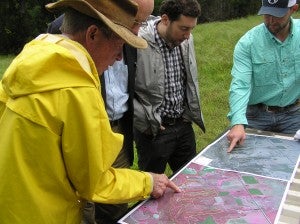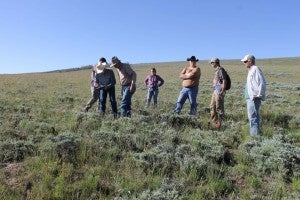
The listing process for the lesser prairie-chicken was tumultuous, with a 2016 ruling that stripped the bird of its previous federal protections and sparked questions about ESA implementation, in addition to what moral obligation humans have to protect wildlife. Photo credit: USDA NRCS
Since the Senate Committee on Environment and Public Works held a hearing two weeks ago to discuss the “Modernization of the Endangered Species Act (ESA),” a new public debate over the act’s effectiveness has begun, even if the arguments on each side haven’t changed much.
On one hand, reform proponents point to the fact that only 47 of 1,652 species have been removed from the Endangered Species List since 1973. On the other, the act’s defenders note that nearly every species on the list has been saved from extinction.
Yet those may be the wrong metrics. Instead, we may want to ask why those species end up on the list in the first place, and whether we are taking common-sense approaches to wildlife conservation before they do.
Wildlife on life support
To use a medical analogy (not uncommon when describing the law), the ESA is a necessary emergency room for endangered wildlife on the brink. The law does a pretty good job at stopping the bleeding and preventing immediate extinction. But as is the case in human health, what’s needed is more preventative care so we don’t have to call the ESA ambulance in the first place.
It just makes sense to focus attention and resources on recovering species before they reach the Endangered Species List. That’s where we can invest dollars more efficiently in advanced conservation and avoid the necessary challenges that come with listings. After all, a visit to the doctor is far cheaper than a visit to the ER.
So who are these wildlife doctors?
Roughly three-quarters of the species listed under the ESA reside on private land, and the vast majority of that private land is used for agriculture. That makes farmers and ranchers to the Endangered Species Act what primary care doctors are to the health care system. They are the first line of defense, the caretakers, the stewards. They know what wildlife need better than anyone, because they know the land. They recognize the trills of the songbirds that fly in their trees.
The ESA’s own Medical Corps

Texas rancher Gene Murph points to the best golden-cheeked warbler habitat on his property. Dr. Murph participated in the Fort Hood Recovery Credit System, earning new revenue for conservation activities that improved the bird’s habitat.
That was the case at Fort Hood, an Army base in Texas Hill Country where nearby ranchers worked with the Army to offset impacts of their training activities on the golden-cheeked warbler’s stronghold habitat. My colleague David Wolfe worked closely with those local ranchers to ensure that conservation activities were efficient and beneficial, both to the landowners and the songbirds.
The benefits to landowners weren’t trivial. Total revenue to the 21 participating landowners amounted to nearly $2 million.
Because of these benefits to participants and the warbler, the Fort Hood program became the blueprint for an incentive-based conservation program known today as habitat exchanges, which works to change the reflex that private landowners have towards wildlife from “shoot, shovel and shut up” to “protect and preserve.” By offering farmers and ranchers a new revenue stream for creating, maintaining and improving wildlife habitat on their property, the exchange is essentially turning them into wildlife doctors, or the ESA’s own Medical Corps.
Supporting wildlife supports landowners
It’s the perfect role for landowners, especially for conservation of a species like the greater sage-grouse. The saying goes, “What’s good for the bird is good for herd,” since many of the conservation activities that benefit sage-grouse are also good for cattle ranching.

The State of Nevada made $2 million in funding available to Nevada landowners, primarily ranchers, who enhance and restore high-quality habitat for greater sage-grouse on their property.
I’ve found that to be the case working with stakeholders in Nevada, Colorado and Wyoming – three sagebrush states that have launched their own versions of a habitat exchange for sage-grouse to attract credit producers and drive investment into projects on the ground, fast. The efficiency with which the Nevada program, for example, was able to allocate over $2 million to about a dozen eager and willing landowners gives me great hope for the future of the bird, and for the program.
By investing more in primary care, we can create more certainty for affected industries and landowners, support the rural lifestyle and economy with new jobs and revenue opportunities, and give wildlife a better chance of recovery.
Ultimately, we can avoid the need to add species to the Endangered Species List altogether.
Related:
Nevada landowners eager to generate conservation credits, help sage-grouse >>
Operation Warbler: Fort Hood and local ranchers team up to save bird >>
Monarch butterflies get help from Texas ranch >>










5 Comments
Please,for the sake of our planet, stop these destructive people.
The reason that congress is hot to repeal the endangered species act is simple and has nothing to do with the animals, other than they are in the way. When they repeal this law it will open up all of the old growth timber to logging, and all of the rivers to dredging, mining and being used as dumps for toxic waste. The swamps and wet lands will be drained and sold to developers. These are the reasons that we need to stop this disastrous ruling before it is too late.
Providing incentive versus punishment! What a novel idea, I will not let any government agency on my land due to the punitive nature of most organizations.
If I could find a way to stop these destructive men and the even more destructive policies they are preposing I would tell the universe. Not enough people believe in just how horrible repealing ESA and EPA legislation will really be or see how this is simply a matter of a select few wanting to make big money at the expense of our lands and our wildlife. I guess when they can’t use their favorite fishing spot or camp ground or find an animal outside of a book they’ll figure it out. This is so depressing.
We all need to do as much as we can and learn new things to help us with this endeavor